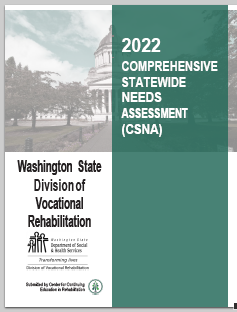DVR conducts analyses and assessments to better understand the experiences and service needs of our customers, with a focus on what customers need to be successful in the workplace. Information and insights gained are used to develop DVR’s State Plan, which describes our strategic goals, priorities, partnerships, and services.
Comprehensive Statewide Needs Assessment (CSNA)
The Comprehensive Statewide Needs Assessment (CSNA) is a study of the vocational rehabilitation needs of individuals with disabilities statewide. The CSNA assesses demographic and economic data; needs of youth and people with the most significant disabilities; underserved populations, including racial and ethnic minorities; and service system factors. The Assessment informs the goals and priorities of DVR’s State Plan and the Division’s understanding of its customers and their service needs. DVR and the Washington State Rehabilitation Council (WSRC) undertake the CSNA jointly and work together to engage partners, customers, and stakeholders in the project.
DVR adds assessments and reports to this site regularly. Readers are encouraged to check back for updates as new information becomes available. Please contact DVRStatePlan@dshs.wa.gov with questions and comments.
2022 CSNA Report
 |
2022 Comprehensive Statewide Needs Assessment (PDF) Report Topics:
*Corrected population information includes American Indian/Alaska Native in October 2023. |
|---|
Transition Self-Assessment Tool (TSAT)
Evaluation Questions:
This evaluation was guided by the following three evaluation questions:
1. How do secondary school transition experts in Washington describe the availability, accessibility, coordination, and quality of school-based transition services that align with one or more of the five pre-employment transition service categories?
2. What additional supports related to pre-employment transition services would school transition experts in Washington like to receive?
3. Do geography or other school-level characteristics account for differences in how respondents describe the availability, accessibility, and coordination of school-based transition services that align with one or more of the five pre-employment transition service categories?
